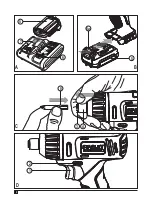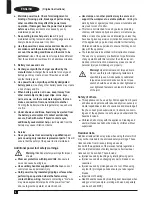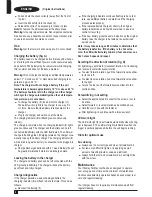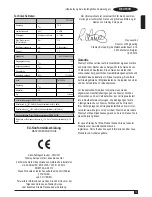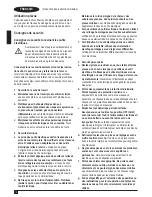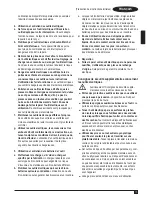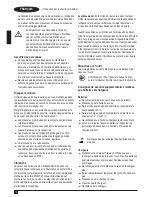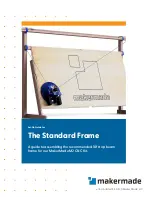
6
ENGLISH
(Original instructions)
u
Pull and hold the chuck collar (4) away from the front of
the tool.
u
Insert the bit shaft (8) into the chuck (3).
u
Release the collar. The accessory is locked in place.
Note!
To remove the bit/socket repeat the above steps.
Warning!
Use only impact sockets. Non-impact sockets may
break and cause a hazardous condition. Inspect socket prior
to use to ensure that it contains no cracks.
Use
Warning!
Let the tool work at its own pace. Do not overload.
Charging the battery (fig. A)
The battery needs to be charged before first use and whenev
-
er it fails to produce sufficient power on jobs that were easily
done before. The battery may become warm while charging;
this is normal and does not indicate a problem.
Warning!
Do not charge the battery at ambient temperatures
below 10 °C or above 40 °C. Recommended charging tem-
perature: approx. 24 °C.
Note: The charger will not charge a battery if the cell
temperature is below approximately 10 °C or above 40 °C.
The battery should be left in the charger and the charger
will begin to charge automatically when the cell tempera-
ture warms up or cools down.
u
To charge the battery (5), insert it into the charger (7).
The battery will only fit into the charger in one way. Do
not force. Be sure that the battery is fully seated in the
charger.
u
Plug in the charger and switch on at the mains.
The charging indicator (8) will flash green continuously
(slowly).
The charge is complete when the charging indicator (8) lights
green continuously. The charger and the battery can be left
connected indefinitely with the LED illuminated. The LED will
change to flashing green (charging) state as the charger occa
-
sionally tops up the battery charge. The charging indicator (8)
will be lit as long as the battery is connected to the plugged-in
charger.
u
Charge discharged batteries within 1 week. Battery life will
be greatly diminished if stored in a discharged state.
Leaving the battery in the charger
The charger and battery pack can be left connected with the
LED glowing indefinitely. The charger will keep the battery
pack fresh and fully charged.
Charger diagnostics
If the charger detects a weak or damaged battery, the
charging indicator (8) will flash red at a fast rate. Proceed as
follows:
u
Re-insert the battery (5).
u
If the charging indicators continues flashing red at a fast
rate, use a different battery to determine if the charging
process works properly.
u
If the replaced battery charges correctly, the original
battery is defective and should be returned to a service
centre for recycling.
u
If the new battery gives the same indication as the original
battery, take the charger to be tested at an authorised
service centre.
Note: It may take as long as 60 minutes to determine that
the battery is defective. If the battery is too hot or too
cold, the LED will alternately blink red, fast and slow, one
flash at each speed and repeat.
Selecting the direction of rotation (fig. D)
For tightening, use forward (clockwise) rotation. For loosening,
use reverse (counterclockwise) rotation.
u
To select forward rotation, push the forward/reverse slider
(2) to the left.
u
To select reverse rotation, push the forward/reverse slider
to the right.
u
To lock the tool, set the forward/reverse slider into the
centre position.
Screwdriving / nut setting
u
Select the appropriate bit / socket for the screw or nut to
be driven.
u
Select forward or reverse rotation as described above.
u
Hold the tool in line with the fastener.
u
After tightening, check torque with a torque wrench.
LED work light
The LED work light (6) is activated automatically when the trig-
ger is depressed. The LED work light will illuminate when the
trigger is partially depressed, before the unit begins running.
Hints for optimum use
Screwdriving
u
Always use the correct type and size of screwdriver bit.
u
If screws are difficult to tighten, try applying a small
amount of washing liquid or soap as a lubricant.
u
Always hold the tool and screwdriver bit in a straight line
with the screw.
Maintenance
Your Stanley Fat Max tool has been designed to operate
over a long period of time with a minimum of maintenance.
Continuous satisfactory operation depends upon proper tool
care and regular cleaning.
Your charger does not require any maintenance apart from
regular cleaning.
Содержание FATMAX FMC041
Страница 1: ...www stanley eu FMC041 1 4 3 6 5 2...
Страница 2: ...2 5 8 7 A 5 5a 4 3 8 C B 1 2 D...
Страница 65: ...65 RCD RCD 3 4...
Страница 66: ...66 5 6 u 8...
Страница 67: ...67 MDF EN60745 2002 44 E 40 C 10 C 40 C p Stanley Fat Max...
Страница 68: ...68 Stanley Fat Max 1 2 3 4 5 6 LED A 7 8 B 5 5a C 2 4 8 3 10 C 40 C 24 C 10 C 40 C 5 7 8 8 LED LED 8 1 LED...
Страница 69: ...69 8 5 60 LED D 2 LED LED 6 LED Stanley Fat Max Z www 2helpU com FMC041 VDC 10 8 0 2500 BPM 0 3400 PTI Nm 110...
Страница 71: ...71...


